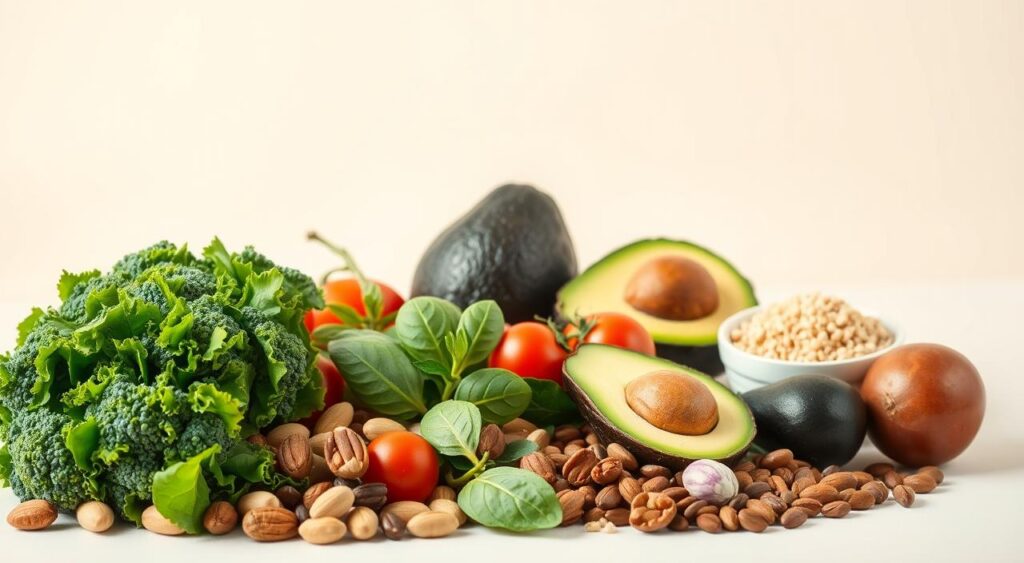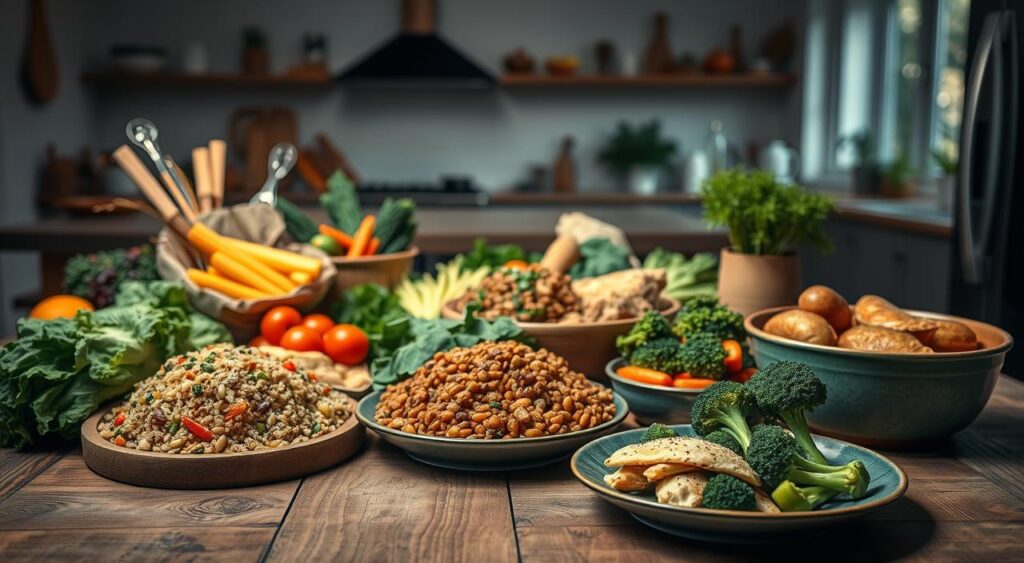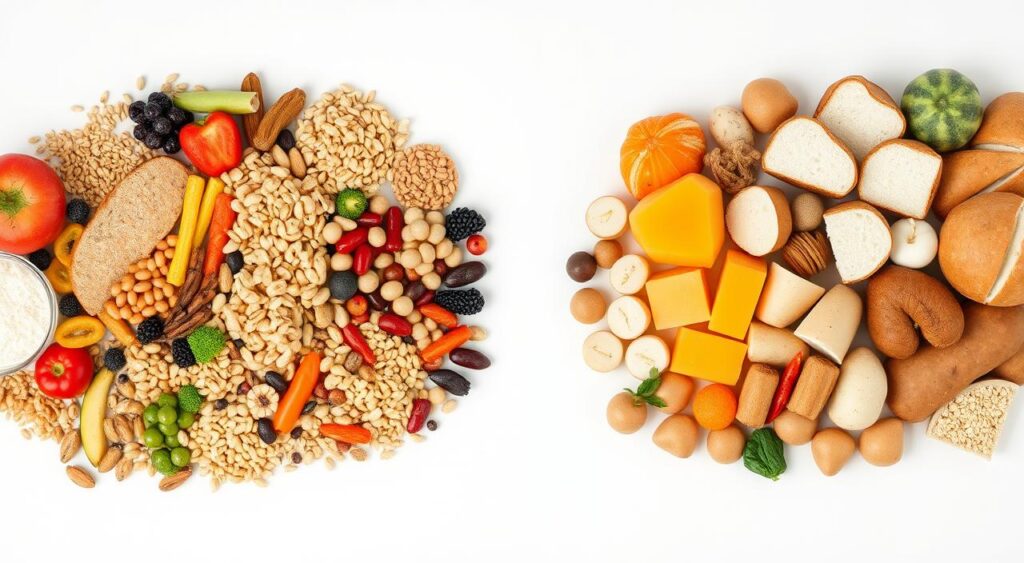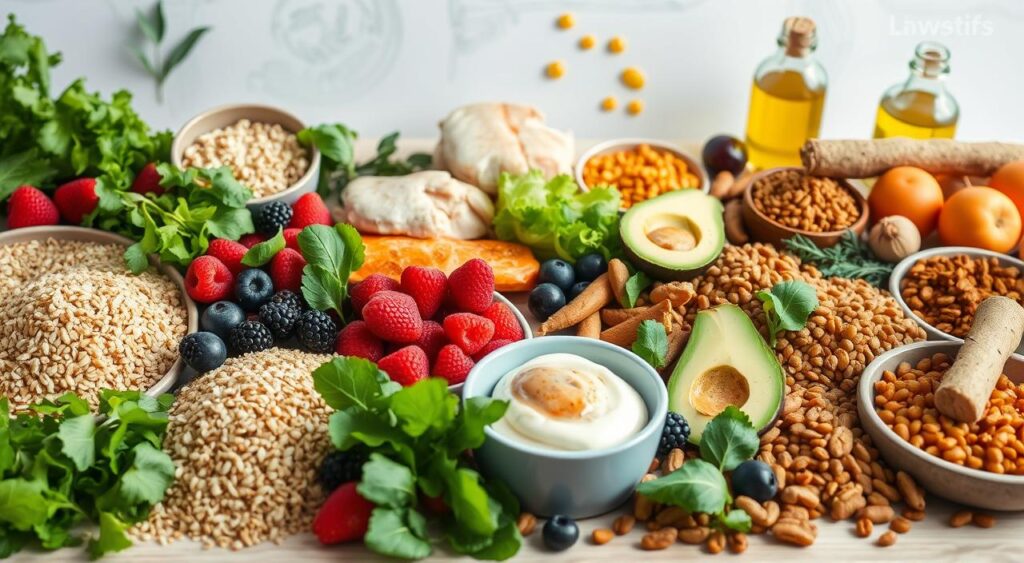Ever noticed how some foods keep you full, while others make you hungry again soon? It might be because of the glycemic index. Learning about low glycemic index foods can really change your health. This guide shows you the top low glycemic foods that are tasty and help with weight and blood sugar.
With science on your side, you’ll find many options that are easy to add to your diet. These foods are not only good for you but also delicious.
Understanding the Glycemic Index
The glycemic index (GI) is a key tool for knowing how foods affect your blood sugar. It rates foods from 0 to 100 based on how fast they raise blood sugar. Glucose, a simple sugar, is set at 100, the standard for all foods.
Foods fall into three groups by GI score: low (55 or less), medium (56-69), and high (70 or more). Knowing this helps those who want to control their blood sugar. Eating low GI foods keeps energy steady and boosts health.
Learning about the glycemic index helps you understand how carbs are digested. High GI foods are quickly digested, causing blood sugar to spike. This leads to energy drops and hunger soon after eating.
Low GI foods, on the other hand, digest slowly. They release glucose into the blood more steadily. This helps you stay full longer and manage energy better.
| GI Category | GI Range | Effects on Blood Sugar Levels |
|---|---|---|
| Low | 0-55 | Gradual increase; stable blood sugar |
| Medium | 56-69 | Moderate increase; possible fluctuations |
| High | 70+ | Rapid increase; spikes and crashes |
Using the glycemic index in your diet can help you choose better foods. This aligns with your health goals.
What Are Low Glycemic Index Foods?
Low glycemic foods help keep blood sugar stable. They slowly raise blood glucose levels. This makes them perfect for managing carbs.
Examples include whole grains, fruits, veggies, legumes, and some dairy. Adding these to your diet helps control blood sugar and can improve insulin sensitivity.
Choose natural, unprocessed options for the best health benefits. For more ideas on low glycemic snacks, check out these great solutions.
Benefits of a Low Glycemic Index Diet
A low glycemic index diet has many health benefits. It can improve your overall well-being. It helps with weight loss, better blood sugar control, and preventing heart disease.
Weight Loss and Management
This diet helps with weight loss and management. Foods with a low glycemic index make you feel full. This leads to eating healthier and keeping your weight in check.
Improved Blood Sugar Control
It also improves blood sugar control. Low glycemic foods keep blood sugar stable. This is great for people with diabetes or insulin resistance. It gives you steady energy and a better mood all day.
Lower Risk of Heart Disease
This diet is also good for your heart. Eating low GI foods lowers LDL cholesterol. This reduces the risk of heart disease and strokes. Choosing low GI foods helps keep your heart healthy.
How to Incorporate Low GI Foods into Your Diet
Adding low GI foods to your meals can boost your health and taste. Begin by checking your current diet for high GI foods. Then, replace them with healthier options like whole grains, legumes, and many fruits and veggies. This change not only satisfies your taste buds but also keeps your blood sugar stable.
Planning your meals is key in this shift. Set aside a day to make meals with low GI ingredients. This way, you can control portions and get the right mix of nutrients. Use a glycemic index chart when shopping to avoid high GI foods.
Healthy snacks are also important. Choose low GI snacks like almonds, yogurt, or berries to curb hunger between meals. These snacks are good for you and taste great. By following these tips, you can easily enjoy the perks of a low GI diet every day.
Low Glycemic Foods List: Best Choices for Your Meals
Looking into a low glycemic foods list can make meal planning easier and healthier. These foods are full of nutrients and keep blood sugar steady. Here are some top picks in different categories.
Fruits
- Apples
- Plums
- Berries
- Cherries
These fruits taste great and are packed with fiber and vitamins. They’re a great choice for your diet.
Vegetables
- Spinach
- Kale
- Broccoli
Adding non-starchy veggies to your meals gives you important nutrients. They also help keep blood sugar from rising too high.
Whole Grains and Legumes
- Barley
- Quinoa
- Chickpeas
- Lentils
These foods are high in fiber and give you lasting energy. They’re key to a balanced low glycemic diet.
Low Glycemic Index Foods for Weight Loss
Adding low glycemic foods to your diet can change how you eat. These include legumes, whole grains, and fruits with less sugar. They help you feel full and reduce cravings, making it easier to eat less.

These foods also release glucose slowly. This means you won’t crash and burn, keeping your energy up all day. Staying energized helps you stick to your diet plan. Choosing these foods leads to more exercise and better health.
| Food Type | Examples | Benefits |
|---|---|---|
| Legumes | Chickpeas, lentils, black beans | High in protein and fiber, keeping you full longer |
| Whole Grains | Quinoa, brown rice, barley | Slow digestion helps stabilize blood sugar levels |
| Low-Sugar Fruits | Berries, apples, pears | Rich in vitamins and minerals, promotes satiety |
By adding these foods to your meals, you boost your health and weight loss chances. This approach leads to a healthier, more balanced lifestyle. It’s good for your body and mind.
Healthy Low Glycemic Snacks
Looking for healthy low glycemic snacks means choosing foods that are good for you without raising your blood sugar. These snacks are not only tasty but also nutritious, great for any time. They keep you energized and full, making them perfect for on-the-go.
- A handful of unsalted nuts provides healthy fats and fiber, aiding in hunger control.
- Fresh fruit like apple slices paired with nut butter creates a delicious and filling treat.
- Carrot sticks with hummus offer a crunchy option full of vitamins and protein.
- A cup of mixed berries or grapes served with cheese cubes gives a sweet and savory balance.
- Unsweetened Greek yogurt with sliced almonds serves as a protein-packed snack to boost your energy.
- A hard-boiled egg is a quick, portable protein source.
- Utilizing low GI leftovers from the night before can also lead to creative snack ideas.
Finding the right healthy low glycemic snacks is easy. These snacks are simple to make and easy to carry, ideal for busy days.
| Snack | Benefits | Low Glycemic Index Value |
|---|---|---|
| Unsalted Nuts | Healthy fats, fiber | Low |
| Apple Slices with Nut Butter | Nutritious, filling | Low |
| Carrot Sticks with Hummus | Crisp, vitamin-rich | Low |
| Berries with Cheese | Sweet-savory combo | Low |
| Greek Yogurt with Almonds | High protein | Low |
| Hard-Boiled Egg | Quick protein | Low |
| Low GI Leftovers | Resourceful, versatile | Variable |
Try these tasty healthy low glycemic snacks to make staying healthy easier. Each snack gives you important nutrients and keeps you full all day.
Sample Meal Ideas for a Low Glycemic Diet
Starting a low glycemic diet might seem hard, but it leads to tasty and filling meals. Here are some ideas to help you add low glycemic recipes to your daily meals. They’re great for any time of day.
Breakfast Options
- Begin with a warm bowl of oatmeal, topped with almond butter and fresh berries.
- Avocado toast on whole grain bread is creamy and very satisfying.
- A smoothie with spinach, Greek yogurt, and a small banana is a refreshing start.
Lunch Ideas
- Try a quinoa salad with mixed veggies, chickpeas, and grilled chicken.
- Lentil soup with a side salad is both comforting and healthy.
- A whole grain tortilla wrap filled with roasted veggies and hummus is delicious.
Dinner Recipes
- Make a colorful stir-fry with tofu, bell peppers, and broccoli.
- Baked salmon with steamed asparagus and brown rice is a tasty choice.
- Fill bell peppers with quinoa, black beans, and spices for a flavorful dish.

Factors That Affect the Glycemic Index of Foods
The glycemic index (GI) of foods can be influenced by several factors. Knowing these helps you make better food choices.
Food Processing greatly affects a food’s GI. Highly processed foods often have higher GI values. This is because they lose important fiber and nutrients. For example, white bread has a higher GI than whole grain bread because it’s more refined.
Cooking Methods also change a food’s GI. Different cooking ways can affect how fast carbs turn into sugars. Cooking pasta al dente instead of soft, for instance, raises its GI. Steaming vegetables helps keep their nutrients and GI low.
Ripeness of fruits is another key factor. As fruits ripen, their sugar content goes up, increasing their GI. A ripe banana has a higher GI than a greener one. Understanding these factors is vital for managing your diet and health.
Low Glycemic Index Foods vs. High Glycemic Foods
It’s important to know the difference between low and high glycemic foods. Low glycemic foods slowly raise blood sugar, giving you energy for a long time. They also make you feel full. On the other hand, high glycemic foods quickly raise blood sugar and then drop it, making you hungry and possibly gaining weight.
Choosing low glycemic foods at mealtime can help control your energy and hunger. Studies show that these foods are good for your health and weight. They help you stay healthy and feel good.

| Food Type | Low Glycemic Index Foods | High Glycemic Index Foods |
|---|---|---|
| Fruits | Cherries, Apples | Watermelon, Pineapple |
| Vegetables | Broccoli, Spinach | Potatoes, Carrots |
| Grains | Quinoa, Barley | White Bread, Rice |
By picking low glycemic foods, you’re choosing a balanced diet. This helps keep your energy up and supports your health goals. It’s all about making smart choices for your body.
Common Misconceptions About Low Glycemic Foods
Many people think that low glycemic foods are always healthy. But, the truth is, their nutritional value can vary a lot. This difference is key to your health. Eating too much of even low glycemic foods can raise your blood sugar.
The Importance of Portion Size
It’s important to eat the right amount of low glycemic foods. Even though they don’t raise blood sugar as much, eating too much can be bad. Eating the right amount helps you get the health benefits of these foods.
Eating a variety of foods is important, not just low GI ones. Focusing only on glycemic index might mean missing out on other nutrients your body needs. Try to eat a mix of low glycemic foods, vegetables, lean proteins, and healthy fats for a balanced diet.
Drawbacks of Following a Low Glycemic Index Diet
A low glycemic index (GI) diet has many benefits. Yet, it’s important to know its downsides. Not all foods with low GI are healthy. They might have lots of sugar, unhealthy fats, or additives that aren’t good for you.
Also, GI doesn’t account for how much you eat. Even if a food has a low GI, eating too much can raise your blood sugar. This makes it hard to know how foods affect you and means you need to watch your portion sizes.
Some people might find it hard to stick to a low GI diet. It can make them feel like they’re missing out. This might lead them to ignore other important nutrients. It’s key to keep your diet balanced, and being too strict can make it hard to do so.

How to Create Your Own Low Glycemic Diet Plan
Creating a low glycemic diet plan empowers you to control your nutrition. Start by looking at what you eat now and note the high glycemic index foods. Knowing which foods raise your blood sugar helps you find better options.
Look for low glycemic foods, like whole and minimally processed items. These foods are better for your body.
Meal preparation is key to a good nutrition plan. Mix proteins, healthy fats, and low-glycemic carbs in your meals. This combo boosts fullness and helps control blood sugar.
For example, choose whole grain or sprouted bread over white bread. Here’s a sample meal plan:
| Meal | Low Glycemic Choice | High Glycemic Choice |
|---|---|---|
| Breakfast | Oatmeal topped with nuts and berries | White toast with jam |
| Lunch | Quinoa salad with veggies | Pasta with sauce |
| Dinner | Grilled salmon with steamed broccoli | Fried rice |
Stay flexible and adjust your diet as your body responds to different foods. This journey is about finding what’s best for you and your health goals.
Conclusion
Adding low glycemic index foods to your diet can help with weight management and better blood sugar control. You can find many tasty and healthy choices that are good for you. These foods support your overall health and well-being.
The low GI diet has some challenges, but with careful planning, it can be part of a healthy lifestyle. It encourages eating foods that are good for you and taste great. These foods nourish your body.
Choosing low glycemic index foods can help you eat healthier. This can lead to lasting success in reaching your wellness goals. So, look into these food options. See how they can improve your daily routine and make your lifestyle healthier.














